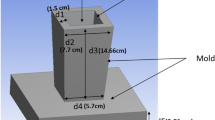Abstract
Critical values of the Niyama criterion were determined for castings from alloy ML10 on the basis of a computational experiment. It was shown that the Niyama criterion is suitable only for qualitative evaluation of the possibility of porosity formation. One of the options of constructing an unambiguous dependence and scale of porosity by the values of the temperature gradient and solidification rate was proposed.






Similar content being viewed by others
REFERENCES
Niyama, E., Uchida, T., Morikawa, M., and Saito, S.A., Method of shrinkage prediction and its application to steel casting practice, AFS Int. Cast Met. J., 1982, vol. 7, no. 3, pp. 52–63.
Hardin, R.A., Ou, S., Carlson, K., and Beckermann, C., Relationship between Niyama criterion and radiographic testing in steel casting, AFS Trans., 2000, vol. 108, pp. 53–62.
Carlson, K.D., Ou, S., and Beckermann, C., Feeding of high-nickel alloy castings, Metall. Trans. B, 2005, vol. 36, pp. 843–856.
Khaled, I., Prediction of shrinkage porosity in Ti–46Al–8Nb tilt-casting using the niyama criterion function, Int. J. Metalcast., 2013, vol. 7, no. 4, pp. 35–41.
MagmaSoft, Magma Giesereitechnologie GmbH, Germany. www.magmasoft.com
Tavakoli, R., On the prediction of shrinkage defects by thermal criterion functions, Int. J. Adv. Manuf. Technol., 2014, vol. 74, pp. 569–579. https://doi.org/10.1007/s00170-014-5995-0
Carlson, K.D. and Beckermann, C., Prediction of shrinkage pore volume fraction using a dimensionless Niyama criterion, Metall. Trans. A, 2009, vol. 40, pp. 163–175. https://doi.org/10.1007/s11661-008-9715-y
PoligonSoft—Sistema komp’yuternogo modelirovaniya liteinykh protsessov (SKM LP) “Poligon” (PolygonSoft— System of Computer Modeling of Foundry Processes (SCM FP) “Polygon”), St. Petersburg, LLC “Fokad”. www.focad.com
onastyrskii, V.P., Monastyrskii, A.V., and Levitan E.M., Development of casting technology for large-size gas-turbine engine blades for power installations using the “Polygon” and ProCAST systems, Litein. Proizvod., 2007, no. 9, pp. 29–34
Poklad, V.A., Ospennikova, O.G., Rudnitskii, S.V., Alferov, A.I., Rodionov, V.I., and Monastyrskii, V.P., Application of CALS technologies at the foundry of FSUE MMPP “Salyut”, Litein. Proizvod., 2007, no. 8, pp. 6–8.
Zhuravlev, V.A., Macroscopic theory of alloy solidification, Russ. Metall. (Metally), 1975, vol. 5, pp. 93–99.
Zhuravlev, V.A., Bakumenko, S.P., Sukhikh, S.M., et al., Theory of formation of closed shrinkage cavities during solidification of alloys in large volumes, Russ. Metall. (Metally), 1983, vol. 1, pp. 37–41.
Vorobiev, I.L., Mathematical theory of castings solidification. Problems of automated production of castings, Tr. Mosk. Vyssh. Tekh. Uchil., 1980, vol. 330, pp. 31–51.
Monastyrskiy, V.P. and Koynov, I.L., Experience of industrial application of commercial software for casting processes simulation, Proc. Modeling of Casting and Solidification Processes VII, Jin, J. et al., Eds., Dalian Univ. Technol., China, 2007, pp. 671–678.
Carlson, K.D., Ou, S., Hardin, R.A., and Beckermann, C., Development of new feeding-distance rules using casting simulation: Part I. Methodology, Metall. Trans. B, 2002, vol. 33, pp. 731–740.
Ou, S., Carlson, K.D., and Hardin, R., Development of new feeding-distance rules using casting simulation: Part II. The new rules, Metall. Trans. B, 2002, vol. 33, pp. 741–755.
Ou, S., Carlson, K.D., and Beckermann, C., Feeding and risering of high-alloy steel castings, Metall. Trans. B, 2005, vol. 36, pp. 97–116.
Funding
This study was supported by the Russian Foundation for Basic Research, scientific project no. 19-38-90099/19.
Author information
Authors and Affiliations
Corresponding author
Additional information
Translated by K. Gumerov
Rights and permissions
About this article
Cite this article
Ivanina, E.S., Monastyrskiy, V.P. & Ershov, M.Y. Quantitative Estimation of Formation of Shrinkage Porosity by the Niyama Criterion. Inorg. Mater. Appl. Res. 13, 100–105 (2022). https://doi.org/10.1134/S2075113322010130
Received:
Revised:
Accepted:
Published:
Issue Date:
DOI: https://doi.org/10.1134/S2075113322010130




